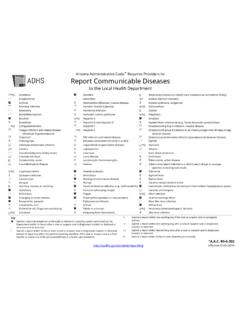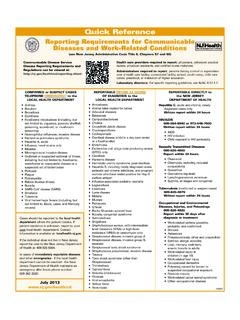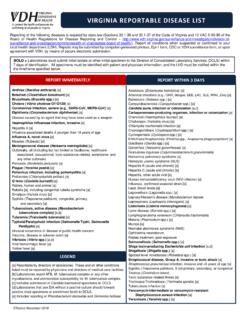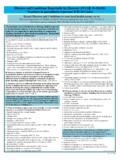Transcription of Understanding Western Blot Lyme Disease Test
1 Understanding the Western Blot By Carl Brenner Revised: September, 1996. Inquiries about various issues relating to Western blot (WB) testing are frequently posted to the lyme Disease discussion groups on the Internet. Among the most commonly asked questions are: What laboratory techniques are used to carry out the assay? What exactly is being measured? What is a band ? How are the results interpreted? What are the CDC. criteria for a positive test? Although some of the medical jargon associated with immunology can be a little overwhelming, the scientific principles behind these tests are not difficult to grasp. The following article is offered as a primer in the techniques and interpretation of Western blotting, and should help most patients navigate their way through some of the medical and scientific terminology associated with the assay.
2 First of all, it should be noted that the Western blot is usually performed as a follow-up to an ELISA test, which is the most commonly employed initial test for lyme Disease . ELISA is an acronym for enzyme-linked immunosorbent assay. There are ELISA tests and Western blots for many infectious agents; for example, the usual testing regime for HIV is also an initial ELISA followed by a confirmatory Western blot. Both the ELISA and the Western blot are indirect tests -- that is, they measure the immune system's response to an infectious agent rather than looking for components of the agent itself. In a lyme Disease ELISA, antigens (proteins that evoke an immune response in humans) from Borrelia burgdorferi (Bb) are fixed to a solid-phase medium and incubated with diluted preparations of the patient's serum. If antibodies to the organism are present in the patient's blood, they will bind to the antigen.
3 These bound antibodies can then be detected when a second solution, which contains antibodies to human antibodies, is added to the preparation. Linked to these second antibodies is an enzyme which changes color when a certain chemical is added to the mix. Although the methodology is somewhat complicated, the basic principle is simple: the test looks for antibodies in the patient's serum that react to the antigens present in Borrelia burgdorferi. If such antibodies exist in the patient's blood, that is an indication that the patient has been previously exposed to B. burgdorferi. Cross-reacting antibodies However, many different species of bacteria can share common proteins. Most lyme Disease ELISAs use sonicated whole Borrelia burgdorferi -- that is, they take a bunch of B. burgdorferi cells and break them down with high frequency sound waves, then use the resulting smear as the antigen in the test.
4 It is possible that a given patient serum can react with the B. burgdorferi preparation even if the patient hasn't been exposed to Bb, perhaps because Bb shares proteins with another infectious agent that the patient's immune system has encountered. For example, some patients with periodontal Disease , which is sometimes associated with an oral spirochete, might test positive on a lyme ELISA, because their sera will react to components of Bb (like the flagellar protein, which is shared by many spirochetes) even Understanding the Western Blot Page 2 of 5. though they themselves have never been infected with Bb. Therefore, some positive lyme Disease ELISA results can be false positives. To distinguish the false positives from the true positives, a more specific laboratory technique, known as immunoblotting, is used. (The Western blot, which identifies specific antibody proteins, is but one kind of immunoblot; there is also a Northern blot, which separates and identifies RNA fragments, and a Southern blot, which does the same for DNA.)
5 Sequences.) In a Western blot, the testing laboratory looks for antibodies directed against a wide range of Bb proteins. This is done by first disrupting Bb cells with an electrical current and then blotting the separated proteins onto a paper or nylon sheet. The current causes the proteins to separate according to their particle weights, measured in kilodaltons (kDa). From here on, the procedure is similar to the ELISA -- the various Bb antigens are exposed to the patient's serum, and reactivity is measured the same way (by linking an enzyme to a second antibody that reacts to the human antibodies). If the patient has antibody to a specific Bb protein, a band will form at a specific place on the immunoblot. For example, if a patient has antibody directed against outer surface protein A (OspA) of Bb, there will be a WB band at 31 kDa.
6 By looking at the band pattern of patient's WB results, the lab can determine if the patient's immune response is specific for Bb. Here's where all the problems come in. Until recently, there has never been an agreed-upon standard for what constitutes a positive WB. Different laboratories have used different antigen preparations (say, different strains of Bb) to run the test and have also interpreted results differently. Some required a certain number of bands to constitute a positive result, others might require more or fewer. Some felt that certain bands should be given more priority than others. In late 1994, the Centers for Disease Control and Prevention (CDC). convened a meeting in Dearborn, Michigan, [1] in an attempt to get everybody on the same page, so that there would be some consistency from lab to lab in the methodology and reporting of Western blot results.
7 IgG and IgM. Before we get to the recommendations that resulted from this meeting, we need to understand one more facet of the human immune response. Many patients have noticed that their Western blot report is actually comprised of two separate parts, IgM and IgG. These are immunoglobulins (antibody proteins) produced by the immune system to fight infection. IgM is produced fairly early in the course of an infection, while IgG response comes later. Some patients might already have an IgM response at the time of the EM rash; IgG. response, according to the traditional model, tends to start several weeks after infection and peak months or even years later. In some patients, the IgM response can remain elevated; in others it might decline, regardless of whether or not treatment is successful. Similarly, IgG. response can remain strong or decline with time, again regardless of treatment.
8 Most WB. results report separate IgM and IgG band patterns and the criteria for a positive result are different for the two immunoglobulins. Finally, in setting up a nationwide standard for a positive WB, one makes several assumptions -- that all strains of Bb will provoke similar immune responses in all patients, that all patients will mount a measurable immune response when exposed to Bb, and that the IgG immune response will persist in an infected patient. Unfortunately, none of these is always true. Therefore, a judicious interpretation of Western blot results in a clinical setting Understanding the Western Blot Page 3 of 5. should take into account both the vagaries of the human immune response and the possibility that strain variations in Bb might produce unusual banding patterns. Official criteria The CDC criteria for a positive WB are as follows: * For IgM, 2 of the following three bands: OspC (21-25), 39 and 41.
9 * For IgG, 5 of the following ten bands: 18, OspC (21-25), 28, 30, 39, 41, 45, 58, 66 and 93. How were these recommendations arrived at? The IgG criteria were taken pretty much unchanged from a 1993 paper by Dressler, Whalen, Reinhardt and Steere [2]. In this study, the authors performed immunoblots on several dozen patients with well characterized lyme Disease and a strong antibody response and looked at the resulting blot patterns. By doing some fairly involved statistical analysis, they could determine which bands showed up most often and which best distinguished LD patients from control subjects who did not have LD. They found that by requiring 5 of the 10 bands listed, they could make the results the most specific, in their view, without sacrificing too much sensitivity. ( Sensitivity means the ability of the test to detect patients who have the Disease , specificity means the ability of the test to exclude those who don't.)
10 Usually, an increase in one of these measures means a decrease in the other.). The IgM criteria were determined in much the same fashion (by different authors in different papers). Fewer bands are required here because the immune response is less mature at this point. Several studies have shown that the first band to show up on a lyme Disease patient's IgM blot is usually the one at 41 kDa, followed by the OspC band and/or the one at 39. The OspC and 39 kDa band are highly specific for Bb, while the 41 kDa band isn't. That's why the 41 by itself isn't considered adequate. Here's the rub, though: the CDC. doesn't want the IgM criteria being used for any patient that has been sick for more than a month or two. The thinking here is that by this time an IgG response should have kicked in and the IgM criteria, because they require fewer bands, are not appropriate for patients with later Disease .







